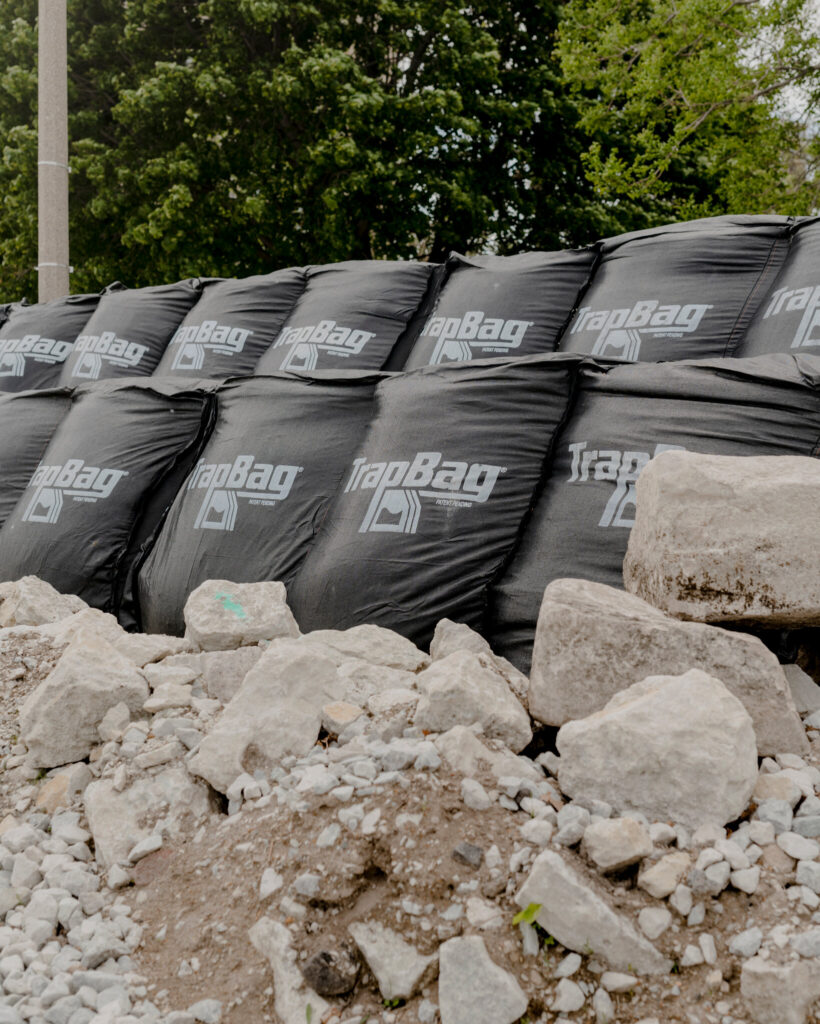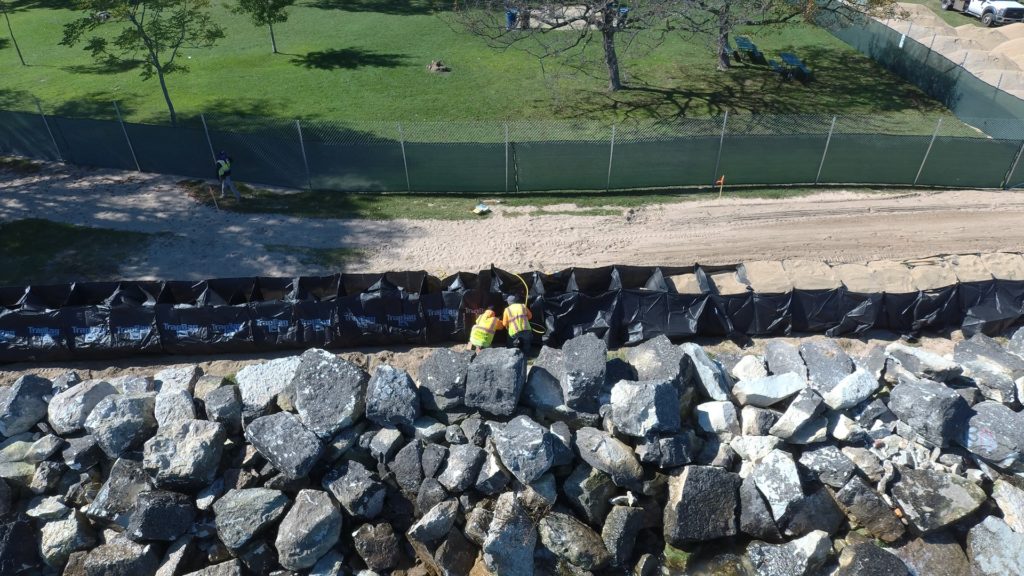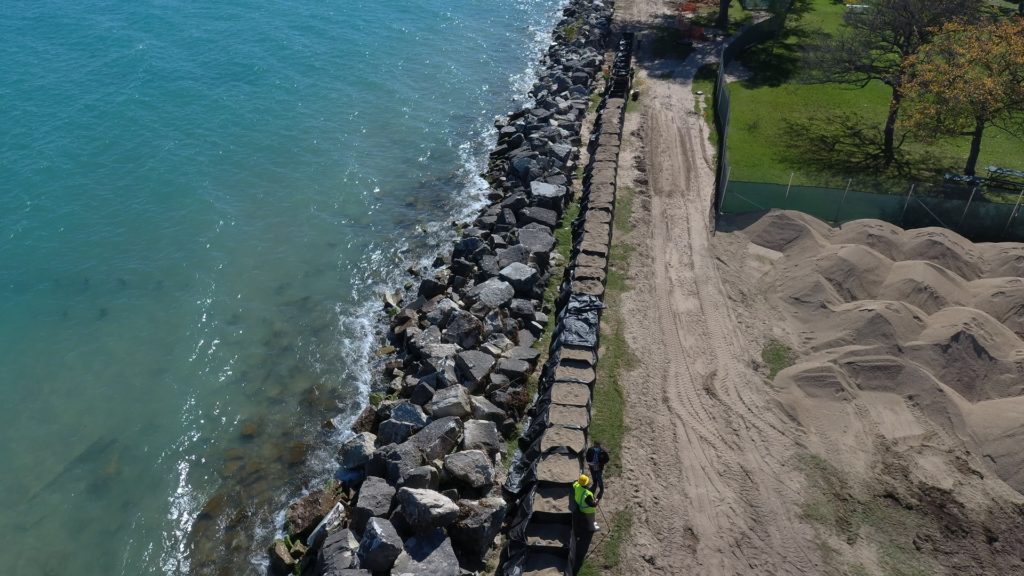Using Rip Rap for Riverbank Erosion
Learn more about the use of rip rap to prevent and control riverbank erosions, as well as the benefits of using TrapBags as an erosion control solution.

What is Riverbank Erosion?
Riverbank erosion refers to the bank of a river wearing away by the effect of water flow. While severe riverbank erosion is most common in rivers that have reached a “mature stage,” it can happen to just about any river.
All river banks are constantly eroding. This is called “fluvial erosion” and happens continuously depending on the strength of the river’s flow and the resistance of the bank’s materials.
Problems only occur during “mass failure,” when the erosion process speeds up and becomes unmanageable. A riverbank can experience mass failure when the weight of its banks becomes too heavy for the soil to support, resulting in complete collapses throughout the river.
You can notice if your riverbank is eroding through a few tell-tale signs. Firstly, if large sections of the riverbank collapse and create a steeper drop to the river, you know you have high-scale erosion. Also, if the tree’s roots near the riverbank become suddenly exposed.
Riverbank Stabilization
Riverbank stabilization is the process of protecting a river or stream bank from erosion. Because most natural soils and clays on a river’s edge (especially for older rivers) aren’t strong enough to support the bank’s weight, stabiliztion is required to prevent the riverbank from collapsing.
Stabilization Methods
Of all the river bank erosion control methods for keeping riverbanks intact, the three most common are hard methods (walls and rip rap), soft methods (vegetation), and geotextile bags.
Hard Methods
Hard methods for river bank stabilization methods involve creating more robust structures and materials to hold the riverbank in place. The most common is rip rap, a large dump of rocks along the river’s edge to prevent the water from eroding the bank. Using rocks to prevent erosion with a concrete retaining wall to make it more effective with Rip rap.
Soft Methods
Planting trees and other vegetation along the riverbank can also help strengthen the soil. The roots will make the ground more tightly packed and support beams when the weight becomes too much.
Geotextile Bags
Geotextiles and geotextile bags are both stabilization systems for rivers , most commonly involving bags filled with solid materials to strengthen a riverbank. The bags can be filled with many materials, from sand to concrete, and can be temporary or permanent depending on the material you use. Geotextile fabric can be utilized in conjunction with other stabilization methods to further improve the riverbank’s strength.
Using Rip Rap to Prevent Erosion Along Riverbanks
As we mentioned before, rip rap river bank protection is a collection of water-resistant rocks and stones placed along the river’s edge to prevent the river’s flow from destroying the bank. Now we can go into more detail about it and its installation process.
What is Rip Rap?
Rip rap is when you place large or small rocks on a river’s edge to prevent erosion.
How to Use Rip Rap
The rocks are usually around 4 inches to two feet long. Municipal engineers place them along river edges but also under bridges and dams to prevent erosion. For stronger rivers and larger embankments, engineers will need to employ larger rocks.
How Does Rip Rap Work?
The rocks hold up the soil on the sides of the river, so it doesn’t collapse under its weight or from the river’s flow.
How Rip Rap Prevents Riverbank Erosion
Usually, the space between the rocks is filled with either soil or smaller rocks. This allows the bank to remain strong even when the river floods. Normally, the soil would be susceptible to collapse if the material isn’t strong enough.
Advantages and Disadvantages of Rip Rap
There are several Rip rap advantages and disadvantages. While rip rap certainly works to prevent erosion, it has its pros and cons compared to other methods.
Advantages
- Easy to install.
- Rip rap is simple to install and doesn’t require high-skilled labor. You just dump the rocks and spread them out accordingly.
- Easy to maintain.
- Rip rap requires almost no maintenance.
- Improves water quality.
- Rip rap can improve water quality by reducing the river’s flow strength and catching trash and pollutants in the rocks as the river flow’s by.
Disadvantages
- More costly than other methods.
- Rip rap costs more to install and replace than other methods for erosion control like vegetation.
- No environmental benefits.
- While rocks don’t harm the environment, they also don’t help it by supporting plant growth.
- Not permanent.
- Sure, the rocks won’t degrade for thousands of years, but they can be moved out of place by the river’s current after a few decades.
Riverbank Stabilization and Erosion Control Considerations
Now that you know how to stop erosion with rocks, you should apply specific criteria to your riverbank to find out if it’s a suitable method for you.
Slope and Bank Steepness
The slope and bank steepness will affect which method you use to protect it. While some banks can have a one-tier system, other steeper banks will require multiple levels of rocks or other methods to keep them safe.
Water or Current Speed
If you have an especially strong river, then you’ll need stronger materials to contain it. Either larger rocks, stronger plants, or more geotextile bags will be necessary for powerful rivers.
Geotextile Use
Geotextiles are the most versatile material for stabilizing a bank. They are made of different materials and vary in strength, so there is an option for every soil. Combined with a rip rap, they can work with very steep banks and powerful rivers.
TrapBags for Riverbank Stabilization and Protection
If you’re not sure about rip rap, then you can try geotextile TrapBags to stabilize your riverbank.
What are TrapBags?
TrapBags are geotextile bags used for riverbank stabilization. You can fill them with many different materials and stack them on a height or incline.
How Can TrapBags Be Used Along Riverbanks?
You can use trap bags along a riverbank by identifying a weak portion and using the bags to reinforce it. Stacking the bags along the bank and covering them in the sediment will keep the river’s natural banks safe from the water’s erosion.
Benefits of Using TrapBags
Trapbags are more affordable than rip rap and easier to install than vegetation. They also allow vegetation to grow over them, making them environmentally beneficial.
FAQs
Now let’s move on to some frequently asked questions about rip rap.
How big should rip rap rocks be?
Rip rap always consists of diverse rock sizes. For stronger rivers and steeper inclines, larger rocks are more effective. You will still need smaller stones to fill in the cracks. Rip rap rocks typically range from 4 inches to two feet long.
What is rip rap made of?
Rip rap is made of natural stones, usually granite or limestone.
How expensive is rip rap?
Rip rap ranges from $30 to $65 for a square yard.
Start Your Project Today With TrapBag
If you want to keep your riverbank protected, then begin your project today with TrapBag. Contact us today to get a quote and start saving your riverbank.
Get the Dirt Before the Flood Hits
Stay ahead of flooding, erosion, and disaster response challenges. The Dirt, TrapBag’s monthly newsletter, delivers field-tested tips, real-world case studies, and the latest in barrier technology straight to your inbox.



